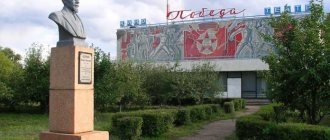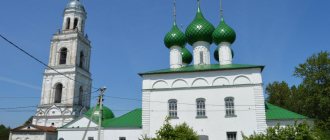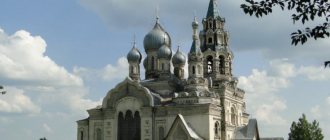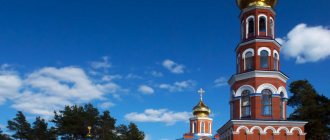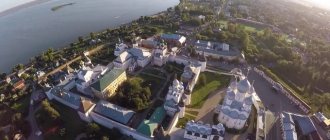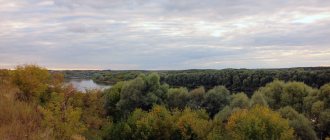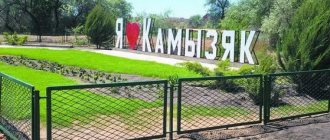Velikoye village, Yaroslavl region. A small settlement with the loud name “Great” is located 41 km from Yaroslavl.
This is one of the oldest villages in the Yaroslavl region. In the Old Russian language the word “great” meant “big”. Nobody knows where such an unusual name of the village came from, there are only different versions. But this is exactly the case when the name hit the target exactly - this village is truly great.
And there is no pathos here, just facts. Why are there so many architectural and historical monuments of federal significance in such a small settlement? In the Middle Ages, this village could rightfully be called the “Great Palace Village”.
General information
In the 12th-13th centuries, the formation of the Russian state took place and, by the will of fate, the village of Velikoye found itself at the crossroads of those historical events. These events include the princely wars, the battle with the Polish invaders, the Patriotic War of 1812 and other historical events.
Russian tsars, Mikhail Romanov and Peter I, stayed in the village more than once. For participation in the Battle of Poltava, Peter I granted the village of Velikoye to Field Marshal Prince A.I. Repnin. In 1712 A.I. Repnin built the Church of the Nativity of the Virgin Mary in the village. This marked the beginning of the large architectural complex of Velikoselsky, which later became known as the Kremlin. Such a complex will do honor to any capital!
The village of Velikoye was also noted as a large trading center, so already in 1607 it was marked on the geographical map of Russia. In the village there was even a moving palace hut for managing the palace Rostov estates.
All the trading people from the surrounding provinces - Vladimir, Kostroma, Yaroslavl, Vologda - came to the fairs and bazaars in the village of Velikoy. Merchants came from Moscow, Nizhny Novgorod, England and Holland. In the middle of the 19th century, the largest Russian flax factory was located in the village of Velikoy. N.A. wrote about this village. Nekrasov and I.S. Aksakov.
The village of Velikoye also owes its wide popularity in those years to such enlightened people as the nobleman Efim Stepanovich Karnovich and his nephew, historian, writer and publicist - E.P. Karnovich.
During the Soviet years, the village of Velikoye gave the country many military leaders, scientists and prominent government officials. Let's outline the main attractions of this wonderful village.
The most unusual Russian Kremlin
Estimated reading time: 3 minutes.
Not every major city has its own Kremlin. What can we say about small towns? But in the village of Velikoy, in the Yaroslavl region, there is its own Kremlin, which is called Velikoselsky.
The village of Velikoye is ancient; the surviving memories of it date back to the 14th century. In the liturgical book of one of the temples in the village, there is a record that in 1392 Russian troops fought here in mortal combat with a detachment of Mongol-Tatars. This is the first written mention of the village. And already in 1435, the Russian princes divided power here - his uncle, Yuri Dmitrievich, with his sons Vasily Kosy and Dmitry Shemyaka, spoke out against the Moscow Grand Duke Vasily the Dark, who sought the political unification of Rus' into a single state.
To the question of why the village is called Veliky, no one can give an exact answer. Some researchers believe that people from Veliky Novgorod who founded the village named it in memory of their homeland. Others claim that the village was named so because it was the largest in the area.
In 1612, the troops of the people's militia of Minin and Pozharsky passed through the village and stopped here for the night. Peter the Great also visited the village of Velikoy. He granted the village to his friend and comrade-in-arms, Field Marshal Prince A.I. Repnin, for military merits and faithful service to the sovereign.
In the center of the village, reflected in the waters of the Black Pond, two huge churches and a high bell tower between them rise above small houses - this is the Velikoselsky Kremlin. And the foundation of this Kremlin was laid by the honored field marshal.
By order of Anikita Ivanovich, the Church of the Nativity of the Virgin Mary was built in the village (1712) - in memory of the victory over the Swedes near Poltava. The church was erected on a Moscow scale.
The temple laid the foundation for the entire architectural appearance of the Great. The field marshal's grandson, Prince Pyotr Ivanovich Repnin, built the second church - the Intercession of the Virgin Mary (1741). Later (1758), between the temples, the Cathedral Bell Tower rose towards the clouds. This bell tower has a “twist” - a symbolic “window to Europe” was cut in the western wall of the bell tower, and its chimes counted down the time that had passed since the Battle of Poltava.
The square in front of the Kremlin with shopping arcades and the Black Pond was the social center of the village. Around this center, the streets of the village spread out in five rings, which were called posads, and these posads were crossed by the so-called settlements, which radiated out from the Black Lake.
The village of Velikoye has one more feature. In the spring, at the time of blossoming of apple trees, it is worth climbing a small hill in the vicinity of the village - and there it is, the village of Great, in full view, immersed in the snow-white blossoms of apple and cherry trees, surrounded by the bright greenery of pouring grains and meadow grasses. This beauty was observed by the great Russian poet N.A. Nekrasov, who often hunted in these places. He wrote the famous lines about these places:
“There's a green noise going on and on.
Green noise, spring noise!
Like drenched in milk,
There are cherry orchards,
They make a quiet noise...”
In September, Velikoy hosts a traditional autumn fair, the history of which dates back to the 19th century, the time of the greatness of the village. Residents of surrounding villages and hamlets come to the fair to show off their goods. An excellent, rich holiday program, rich shopping arcades, exhibitions and sales of products by masters of arts and crafts, competitions, games and fun for adults and children, a quest game, a laser show, a disco, fireworks and much more make this holiday unforgettable!
What else to see:
In addition to the “famous” Kremlin, in the village of Velikoy you can visit the Museum of the Potato Riot, the Museum of Local Lore and see the mansion of the merchant Alexander Alekseevich Lokalov, which now houses an orphanage.
How to get there:
Yaroslavskoye Highway, at the 253rd kilometer turn right at the “Gavrilov Yam” sign, then continue 11 kilometers.
Text and photo by Vladimir Eshtokin
How to get into the “Foma” news photo feed
Review
- The famous Velikoselsky Kremlin
This is a magnificent architectural complex in the center of the village. There is nothing like this in any Russian village! The complex includes two churches, a high seven-tier bell tower, fragments of a surviving protective wall, the remains of shopping arcades and several towers.
In 1712 A.I. Repnin erected the Church of the Nativity of the Virgin Mary in honor of the victory in the Battle of Poltava. The temple was built by local stone craftsmen, and the building materials were also used locally. Later (in the first half of the 18th century), the Intercession Church and the belfry were erected nearby. The construction of this church was carried out by the grandson of A.I. Repnin. One temple was intended for summer services, the other for winter ones. In the Church of the Nativity of the Virgin Mary, wonderful frescoes on the vaults and walls have still survived.
The seven-tiered red brick stone bell tower was built in 1758. Its height is 75 m. This architectural complex suffered its greatest losses after the revolution, during the Soviet era.
Currently, restoration of the Velikoselsky Kremlin is underway.
- Mansion A.A. Lokalova
This mansion was built in 1890 by the son of merchant A.V. Lokalov, owner of the famous Velikoselskaya flax spinning factory. The mansion was built according to the design of the famous architect F.O. Shekhtel.
This magnificent stone two-story building is made in pseudo-Russian style. It is decorated with numerous decorative elements: mosaics, tiles, semi-columns, kokoshniks, high and narrow windows and a turret with a spire. The interior design of the mansion matched its external appearance. The building has survived to this day, but requires restoration. Nowadays this building houses an orphanage.
- House of P.D. Irodova
This is the second stone building built by architect F.O. Shekhtel in the village of Velikoy. It is also an architectural monument of federal significance. Try to find another village where there are stone mansions built by the famous architect F.O. Shekhtel!
- Velikoselsky Local Lore Museum
The museum is located in a two-story stone mansion that once belonged to the merchant Butikov.
In general, this is an ordinary local history museum, the main task of which is to highlight the history of the village of Velikoye. The museum exhibits an interesting collection of antique linen towels, utensils, and personal belongings of residents of the village of Velikoye. From these items you can understand how merchant life and peasant crafts were organized. A separate room is dedicated to the theme of the Soviet period and the Great Patriotic War. The museum also houses paintings and sculptures by local artist A.V. Yashin.
- House number 19 on Yaroslavskaya street
This is a small old stone mansion. There is a memorial plaque on this mansion that says that Tsar Peter I stayed here. Nothing is known about the owner of this house.
- Church of the Bogolyubsk Icon of the Mother of God
Located on the Western outskirts of the village.
It was built in 1847 with donations from parishioners and money from church warden Mikhail Krasheninnikov. It is a stone, one-story, single-domed building with columns and a multi-tiered bell tower. Currently the church is active.
- Church of the Tikhvin Icon of the Mother of God
Located on the northern outskirts of the village. This was also an old brick one-domed altar church. Once upon a time there was an Old Believer church on this site.
In 1861, the Church of the Tikhvin Icon of the Mother of God was erected. Unfortunately, now only ruins remain of it. But even from these ruins one can understand how interesting the architectural style of this church was. I would really like to see it restored.
- Monument to the “Great Villagers” who fell during the Great Patriotic War.
The monument is located next to the Velikoselsky Kremlin. It is a mournful sculpture of a soldier with a machine gun in his hands and wearing a helmet, mounted on a pedestal. The sculpture is very expressive.
“The city that did not happen”: the history of the village of Velikoye
Velikoye is the largest village in the Yaroslavl region, which is not the administrative center of the district. Three centuries ago it was one of the important trading centers in Russia. Thanks to its past, this village may be more interesting for tourists than many large cities. Read about where to find Peter I’s “window to Europe” near Yaroslavl, see the house in which the Tsar lived, and learn the history of the “city that never happened.”
Royal gift
In the 17th century, the Great was in the possession of the Romanov dynasty and was inherited by members of the royal family. Peter I visited it especially often. This is due to the fact that the village was an important trading center and was located at the intersection of trade routes. Local residents talk with pride about the king's visits.
“
According to surviving documents, Peter I came to our village six times and always stayed in a house with vaulted ceilings,” shared Galina Sutugina. “There are only two such buildings in Velikiy, but it is not known for certain where the king lived. However, on one of them there is still a sign: “In this house, according to legend, in 1702-1705. Emperor Peter I stayed. Autocrat of All Great, Little and White Rus'.”
The sign contains a historical error. It says: “Emperor Peter I,” but at that time he was just a sovereign.
In 1709, the Tsar presented the Great to his friend and associate, Field Marshal General Anikita Ivanovich Repnin, for the defeat of Sweden in the Battle of Poltava. For Peter I, victory in this war was incredibly important. The Emperor dreamed of access to the Baltic Sea, which would allow Russia to establish direct trade relations with Western countries and build a fleet there.
In the Battle of Poltava, Prince Repnin commanded twelve infantry regiments in the vanguard. By the way, it was this triumph of the Russian army that became the turning point in the Northern War, which subsequently led our country to victory.
When Anikita Repnin arrived in Velikoye, many of the buildings in the village were wooden. Because of this, fires often broke out there. The prince tried to solve this problem with the help of reconstruction.
— He introduced a ring system according to
the St. Petersburg principle.
The posads (streets -
editor's note ) were organized as follows: 10-15 stone houses stood close to each other, and between them there was a small alley to make it convenient to move around the village and put out fires.
The very first central area was allocated for shopping arcades. 25 people worked there every day. In addition, artisans held bazaars twice a week. Every autumn, in honor of the feast of the Church of the Nativity of the Virgin Mary, a two-week fair was traditionally held. In the first days of September, not only Russians, but also foreigners - Belgians, Dutch, and English - came to Velikoye. Everyone wanted to buy the famous Yaroslavl bleached linen.
Velikoselsky Kremlin
Thanks to the military leader, one of the main attractions appeared in the village - the Church of the Nativity of the Virgin. The church was built on a metropolitan scale. The six-pillar temple is a dynamic and majestic pyramid-centric composition facing upward - towards God. In the 18th century there were only nine such churches in Russia, one of them was the Assumption Cathedral of the Moscow Kremlin.
The walls of the Velikoselskaya Church are painted with frescoes based on the Gospel story. Each new image is a separate page of the holy book.
It is worth noting that the church choir is unusually located in the temple. A place for it is allocated above the altar, due to which the sound is evenly distributed throughout the hall, and parishioners cannot understand where the singing is coming from.
“Prince Repnin wanted the church to be unique, and everyone could find their place there,” added the local historian. — When the temple was erected, the population of the village exceeded five and a half thousand people, and then the space of the shrine was completely filled.
After the death of Anikita, his grandson Peter Repnin built a second church - the Intercession of the Virgin. And 17 years later, in 1758, the Cathedral Bell Tower appeared between them. A symbolic “window to Europe” was cut through one of the walls of this tower, through which people looked to the West and remembered Emperor Peter I.
Tuberculosis epidemic
Despite the reconstruction of the village, fires continued. After it once again burned to the ground, it was sold for next to nothing to one of the richest people of the 18th century, Savva Sobakin. The merchant did not come to the Yaroslavl province of his own free will. After the victory over the Turks, Empress Catherine II ordered a big celebration and treated everyone to a glass of vodka. Sobakin, the manager of the pub, added his own expenses to these expenses, saying that the treasury would not become poorer. The Empress was informed about this, she became very angry with Savva and expelled him from St. Petersburg.
At this time, the inhabitants of Velikiye were mainly engaged in crafts - they processed flax, sewed boots and clothes, prepared sausages, traded horses, and worked in forges. This did not bring any profit to the village and did not replenish its treasury. Sobakin wanted to develop Velikoye and decided to build the first large enterprise there - a flax spinning and weaving factory.
“It didn’t last very long,” said Galina Nikolaevna. — When processing flax, a lot of dust rose into the air, and the workers breathed it. The production quickly led to an epidemic of tuberculosis in the village, and local residents turned to the head of the Yaroslavl province, Alexei Melgunov, with a request to close the factory.
"The City That Never Happened"
Arriving in Velikoye, you can hear that it is called “the city that did not happen.” And this is not without reason. A little later, after the closure of the flax spinning and weaving factory, on the initiative of Governor General Alexei Melgunov, they wanted to give the village the title of city. However, it was not possible to bring the idea to life, because the Great was still in the private property of Savva Sobakin.
Almost a century later, merchant Alexander Lokalov wanted to build a factory and a railway here.
But local residents were categorically against the planned enterprise, fearing a new tuberculosis epidemic. Then it was built seven kilometers from the village. This is how the Gavrilov-Yamskaya linen manufactory appeared, and Velikoye forever remained a village. The material was prepared jointly with the Yaroslavl branch of the Russian Geographical Society
Conclusions and video
It should be noted that at the peak of its heyday (150 years ago), about 5,000 people lived in the village! It looked more like a respectable county town rather than a village.
Another amazing feature of the village of Velikoye can be considered its unusual development. In the center of the village there is Black Lake. All the streets run from the Black Pond in widening rings, which gives the village a unique flavor.
The name of the lake apparently comes from the times when forges and brick factories stood on its shores.
